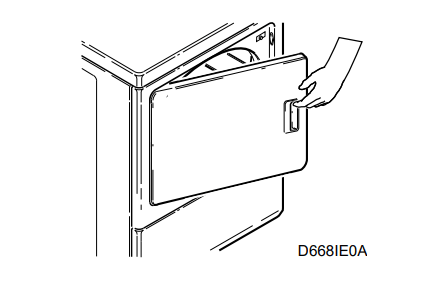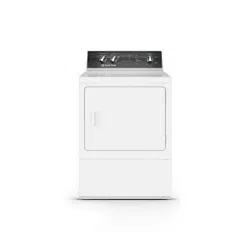Documents: Go to download!
User Manual
- User Manual - (English)
- Quick Start Guide - (English)
- Installation Intructions - (English)
- Quick Specification - (English)
- Before Drying
- Operating Your Dryer
- Maintenance
- Troubleshooting
Table of contents
User Manual Electric Dryer
Before Drying
Energy Saving Tips
- Make sure the lint filter is always clean.
- Do not overload the dryer.
- Do not overdry items.
- Remove items to be ironed while still damp.
- Large loads of similar fabrics dry the most efficiently. However, dry permanent press in smaller loads to prevent wrinkling.
- Use the correct cycle for the type of fabric being dried.
- Locate your dryer so the exhaust duct is as short and straight as possible.
- Do not open the door during the drying cycle.
- Plan to do your laundry on low humidity days; your clothes will dry faster.
- Dry multiple loads of clothes one right after another so dryer interior does not have to be reheated for each load.
Helps and Hints
WARNING To reduce the risk of fire, explosion, serious injury or death, clothes which have traces of any flammable substances such as cooking oil, machine oil, flammable chemicals, thinner, etc. must not be put into the dryer.
- The directions for installation and proper exhausting are given in the Installation Instructions which are included with the dryer.
- Static electricity may cause garments of synthetic fibers (as in lingerie) to cling together, especially if they are overdried. The use of a liquid fabric softener in the rinse water of the washer, or a fabric softener sheet in the dryer, will soften clothes and reduce static electricity.
- Do not wash or dry clothes that shed lint in the same load with permanent press or knit garments.
- Remove permanent press loads immediately after dryer stops.
- Follow the care labels on FLAME RETARDANT, SCOTCHGUARD™, etc., garments for proper washing and drying.
- If loads should be damp for ironing, use the Damp Dryness setting, in an Automatic cycle.
Sort
If you have correctly sorted the items for washing, they should be properly sorted for drying too.
- Sort by color.
- Separate lint shedding fabrics and lint receiving fabrics. Towels, flannels, chenille, cottons, rugs, etc., shed lint. Corduroys, knits (including socks), permanent press, and synthetics attract lint.
- Separate no heat, low heat and high heat items. In any kind of drying, lightweight fabrics will dry faster than heavyweight fabrics.
If mixed loads are dried together (such as sheets and towels), remove the lighter weight fabrics when they are dry to prevent overdrying and wrinkling. The best method is to dry clothes which require the same time, temperature or dryness level in the same load.
Load
WARNING Do not wash or dry items soiled with vegetable or cooking oils. Some oils may remain after washing and may cause the fabric to catch on fire by itself.
- Do not overload your dryer. Bulk, not weight, determines the load size. If the dryer is overloaded, it could cause discoloration or permanent heat damage to the load.
- There should be space in the dryer for the clothes to tumble freely and help to reduce wrinkles.
- Large and small pieces together make up loads which will tumble well. Permanent press loads should be smaller to provide room for tumbling. Proper tumbling allows for fewer wrinkles.
- A load can be too small. Just a few small pieces will not tumble properly. They will take longer to dry and they may be wrinkled. For small loads, add a couple of large towels or non lint shedding items to aid in tumbling.
- The following illustrations show the ideal load sizes for fabrics. The average load will fill the cylinder one third to half full when wet.
Cylinder with wet linens and cottons
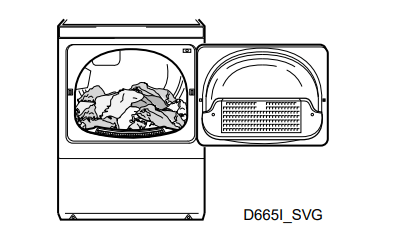
Cylinder with wet permanent press items
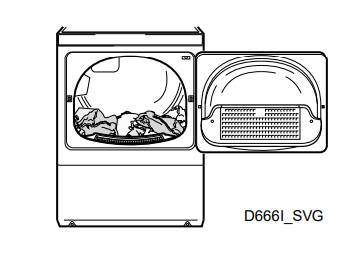
Operating Your Dryer
Dryer with Timer Knob Start:

Dryer with Start Button:

WARNING To reduce the risk of fire, electric shock, serious injury or death to persons, read the Safety Information section before operating the dryer
Available Drying Cycles
NOTE: Use the automatic cycles for drying items that can be dried with heat. These cycles automatically dry loads to the dryness level selected.
MAX DRY and MORE DRY will dry very small loads and some heavy items, such as blue jeans, but will overdry lightweight items, such as sheets and shirts.
Overdrying can cause wrinkling, shrinking, excessive lint conditions, and will use more energy than necessary.
LESS DRY, which uses the least energy, will dry large loads and lightweight items, such as sheets and shirts, but might leave other items, such as denim and heavy bath towels, more damp.
To increase energy savings and to make sure loads are dried without overdrying, set your loads on LESS DRY. If items are damp at the end of a cycle, the timer knob needs to be set closer to the MORE DRY setting the next time these loads are dried. If items are overdry at the end of a cycle, the timer knob should be set closer to COOL DOWN when these loads are dried again. Remember the settings that work best to get ideal drying results
The COOL DOWN period at the end of each cycle provides items a chance to tumble with no heat and cool down to room temperature. This prevents wrinkles from setting if items cannot be cared for immediately.
The EXTENDED TUMBLE setting continues to tumble items at no heat after the cycle has completed. This prevents wrinkling when garments cannot be removed from the dryer immediately. By pressing the EXTENDED TUMBLE button to ON, the AUTOMATIC REGULAR/DELICATE and AUTOMATIC PERM PRESS/ KNITS cycles will tumble an additional 40 minutes.
NOTE: The timer knob will not advance as quickly in the AUTOMATIC cycles as it does in the TIMED DRY cycle. The time it takes for the timer to advance depends on the type and size of the load being dried.
The ENERGY SAVER settings, marked with a dot, show which settings will use the least energy and will leave items damp for easier ironing.
Automatic Regular/Delicate Cycle
Use for sturdy items like play or work clothes and also for delicate items. The type of heat is determined by choosing the proper Fabric Selector option. There are three settings in the AUTOMATIC REGULAR/DELICATE cycle - MAX DRY, MORE DRY, and LESS DRY.
Timed Dry Cycle
This cycle will operate dryer for up to 75 minutes. Cottons and heavyweight items dry best between 50 and 75 minutes, and lightweight items dry best between 20 and 40 minutes.
Automatic Wrinkle Out Cycle
Use this for items that are slightly wrinkled after sitting in a dryer or laundry basket overnight. The cycle has a short heat setting followed by a 15 minute COOL DOWN.
Automatic Perm Press/Knits Cycle
Use for permanent press items and synthetics. The type of heat is determined by selecting the proper Fabric Selector option. There are three settings in the AUTOMATIC PERM PRESS/ KNITS cycle: MORE DRY, LESS DRY and COOL DOWN.
To Dry Clothes
IMPORTANT: Refer to the INSTALLATION INSTRUCTIONS before using dryer.
IMPORTANT: Before using dryer for the first time, use an all-purpose cleaner or a detergent and water solution and a damp cloth to remove shipping dust from inside of dryer drum.
- Sort items into separate loads.
- NOTE: Remove all sharp objects from laundry to avoid tears and rips to items during normal machine operation
- Clean lint filter.
 WARNING To reduce the risk of fire and risk of lint collecting in exhaust duct, do not operate dryer without lint filter in place.
WARNING To reduce the risk of fire and risk of lint collecting in exhaust duct, do not operate dryer without lint filter in place.
- Load dryer half full with laundry ( 8.2 kg [18 pounds] ) maximum dry clothes load). Add fabric softener sheet, if desired.
- NOTE: To avoid damage to dryer, do not use more than one fabric softener sheet per load.

- Close loading door. Dryer will not operate with the door open.
- Select Fabric Selector. Follow garment manufacturer's care labels for recommended temperature settings.
- Select optional EXTENDED TUMBLE setting to continue tumbling items at no heat.
- Select timer setting in cycle desired. These cycles control the drying time. The ENERGY SAVER settings, marked with an asterisk (*), show which dryer settings will use the least energy and will leave items damp for easier ironing.
- Push start button if available or push in timer knob to start dryer.
NOTE: To stop dryer at any time, open the door or turn timer knob to an off position. To restart dryer, close door, reset timer if necessary, and push start button or push in the timer knob.
End Of Cycle Signal
The volume of the signal tone may be set on OFF, LOUD or between the two selections. If a volume level is selected, the signal will let you know when the cycle is done. The signal will stop when the door is opened, or when the timer is advanced to an OFF position.
NOTE: The signal will come on every 10 minutes when the optional EXTENDED TUMBLE setting is selected.
Optional Drying Rack
A drying rack, Part No. D512082, is available at extra cost through your Factory Authorized Service Center. The drying rack can be used in manual cycles only for no-tumble drying of articles such as tennis shoes, sweaters, stuffed toys or other delicate items.
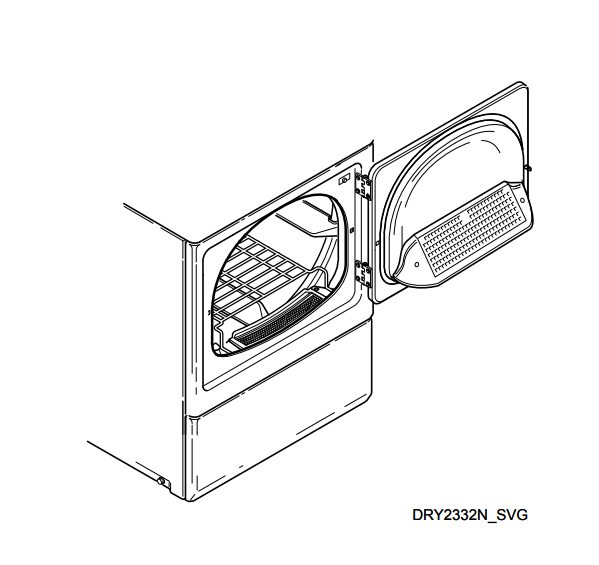
Maintenance
Lubrication
All moving parts are sealed in a permanent supply of lubricant or are equipped with oilless bearings. Additional lubrication will not be necessary.
Care of Your Dryer
WARNING To reduce the risk of an electric shock, serious injury or death, disconnect the electrical service to the dryer before cleaning the interior.
Dryer Interior
Wipe the surfaces using a soft cloth and household cleaner or a non-abrasive paste of powdered laundry detergent and hot water, followed by a short heat cycle with a load of rags.
To remove crayon or ball point ink off the dryer drum, put the heat on high and use old rags in the dryer to absorb the crayon or ink.
If unsuccessful, contact the appliance dealer. DO NOT use any chemicals in the dryer.
IMPORTANT: The use of chlorine bleach for removing any discolorations should be avoided because bleach could damage the finish.
Cabinet
Wipe the dryer cabinet as needed. If detergent, bleach or other washing products have been spilled on the dryer, wipe immediately. Some products will cause permanent damage if spilled on the cabinet.
Control Panel
Use only a damp or sudsy cloth for cleaning the control panel. Some spray pretreat products may harm the finish on the control panel. DO NOT use products that contain alcohol on the control panel.
Exhaust System
WARNING To reduce the risk of electric shock, disconnect the electrical service to the dryer before cleaning.
WARNING Any disassembly requiring the use of tools must be performed by a suitably qualified service person.
The exhaust duct should be inspected after one year of use and cleaned if necessary by a qualified service person to remove any lint build-up. Inspect and clean exhaust duct every one to two years as required thereafter. Every two years a qualified service person should remove all front panels and vacuum the inside of the dryer
NOTE: This recommended maintenance is not covered under the terms of the warranty.
The weather hood should be checked frequently to make sure the dampers move freely, dampers are not pushed in and that nothing has been set against them. Keep dryer area clear and free from combustible materials, gasoline and other flammable vapors and liquids. Do not obstruct the flow of combustion and ventilation air.
NOTE: Verify proper operation after servicing
Lint Filter
The lint filter is located at the front of the dryer in the lower part of the door opening.
CLEAN THE LINT FILTER BEFORE DRYING EACH LOAD. Annually remove lint filter and screw to vacuum the duct under it.

Cylinder Light
If the dryer cylinder light needs replacment, order 10 Watt bulb, part number 60954.
Troubleshooting
Try these troubleshooting tips before making a service call. They may save you time and money.
| Dryer Symptom | Possible Cause/Solution |
| Dryer won’t start |
|
| Dryer won’t heat |
|
| Dryer doesn’t dry clothes satisfactorily |
|
| Dryer is noisy |
|
| Clothes are too wrinkled |
|
| Clothes have odor |
|
| Cycle advances too slowly |
|
See other models: DR7 FF7 TC5 TR3 TR5
